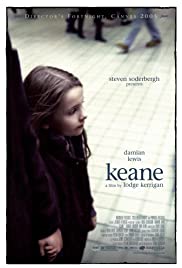
KEANE
US, 2004, 100 minutes, Colour.
Damien Lewis, Abigail Breslin, Amy Ryan.
Directed by Lodge Kerrigan.
Quite a powerful film but one which many audiences might find too demanding, not for the subject but for the intensity of the style and the close-up portrait of a disturbed man.
All of the camera work is handheld and stays close to its subject who is in every sequence, seen very often in close-up, sometimes extreme close-up so that we share his anxieties, his doubts, the turmoil of his memories and feelings.
The man is played by British actor Damian Lewis, here convincingly American. We see him talking to himself, desperate, at New York’s Port Authority. He is looking for his abducted daughter. He wanders the streets, sleeps outdoors, takes a room in a seedy hotel, buys clothes for his daughter, looks for drugs, tries for work. He also encounters a mother who is staying in the hotel with her little daughter and helps them with money. The mother trusts her daughter to him while she tries to contact her husband who is working in another city. What will the man do? How will he treat the little girl? What effect will all this have on him.
For 90 minutes we stay with Keane – his name is William Keane – and share his intensity. Dramatically and psychologically, the film, the screenplay, Damian Lewis’ performance are a tour-de-force of cinema communicating something of what mental illness must mean to the person suffering and the effect on those in the ambit of the sufferer.
On the whole, the treatment is realistic rather than sensational which makes it all more effective. The little girl is played by the very talented Abigail Breslin (Signs, Raising Helen) who a year later was so convincing in Little Miss Sunshine.
1. The impact of the film, portrait of a suffering man, portrait of suffering, insights into human nature?
2. The work of the independent film-maker? His script, cast, low budget? The locations, authentic, the aesthetic of the hand-held camera for realism? Framing, close-ups? The blend of portrait, action, tension? The overall effect? The musical score?
3. The style of photography, colour, naturalism?
4. Damien Lewis's performance, in every sequence? The introduction to him and his character, credible? Audience sympathy, puzzle and questions? Talking to himself, the Port Authority, the buses, the search, at the ticket counter, the touch of madness, the photo, the story about his abducted daughter, the search?
5. The development of his character, going out of the Port Authority, eating at the diner, sleeping out on the road, going to the hotel, paying, described as disabled, sleeping in his room, looking
for work, not finding it, buying the children's clothes, asking the woman the size, the drug deal, taking the drugs and its effect, his drinking the beers, the encounter with the woman, the sex in the toilet, casual, unprotected? The phone call and no answer? Audiences trying to assess his mental state?
6. His hearing Lyn and her daughter, giving them the hundred dollars, Lyn's reaction, his not having any expectations, not staying? The later visit, talking to Lyn, her life story? Her offering him the meal? The kiss, his going away? Her needs? His needs? Her having to see her husband, asking him to collect Kira from school, the parallel with his own daughter, going to the school, being late, taking her out, the various visits, the enjoyment, the meal, bringing her back, putting her to sleep? A certain audience tension as to what he would do? Care for the girl?
7. Lyn, her background, trying to make ends meet, her husband going north to get a job, trying to get him on the phone, her asking Keane to look after Kira? The phone call, her going to meet her husband? Her not getting back - and it seeming that she had abandoned her daughter?
8. Kira, her age, vitality, doing her homework, relating to Keane, longing for her father, asking whether he was going to be her mother's new boyfriend, at school, her chatting with Keane, the outing, her enjoying it, ice cream, going to sleep?
9. The plan, Keane taking Kira, going to the Port Authority, buying the ticket, saying they were waiting for her mother, at the bus station, the effect, her going to look at the dolls, buy
something, his change of heart, the decision to go back? The end of the film at that moment? Audiences anticipating his decision and behaviour?
10. A portrait of the mentally disturbed? The issue of whether his daughter had really been abducted or he had imagined it? The portrait of Keane, audience empathy - and the open end?